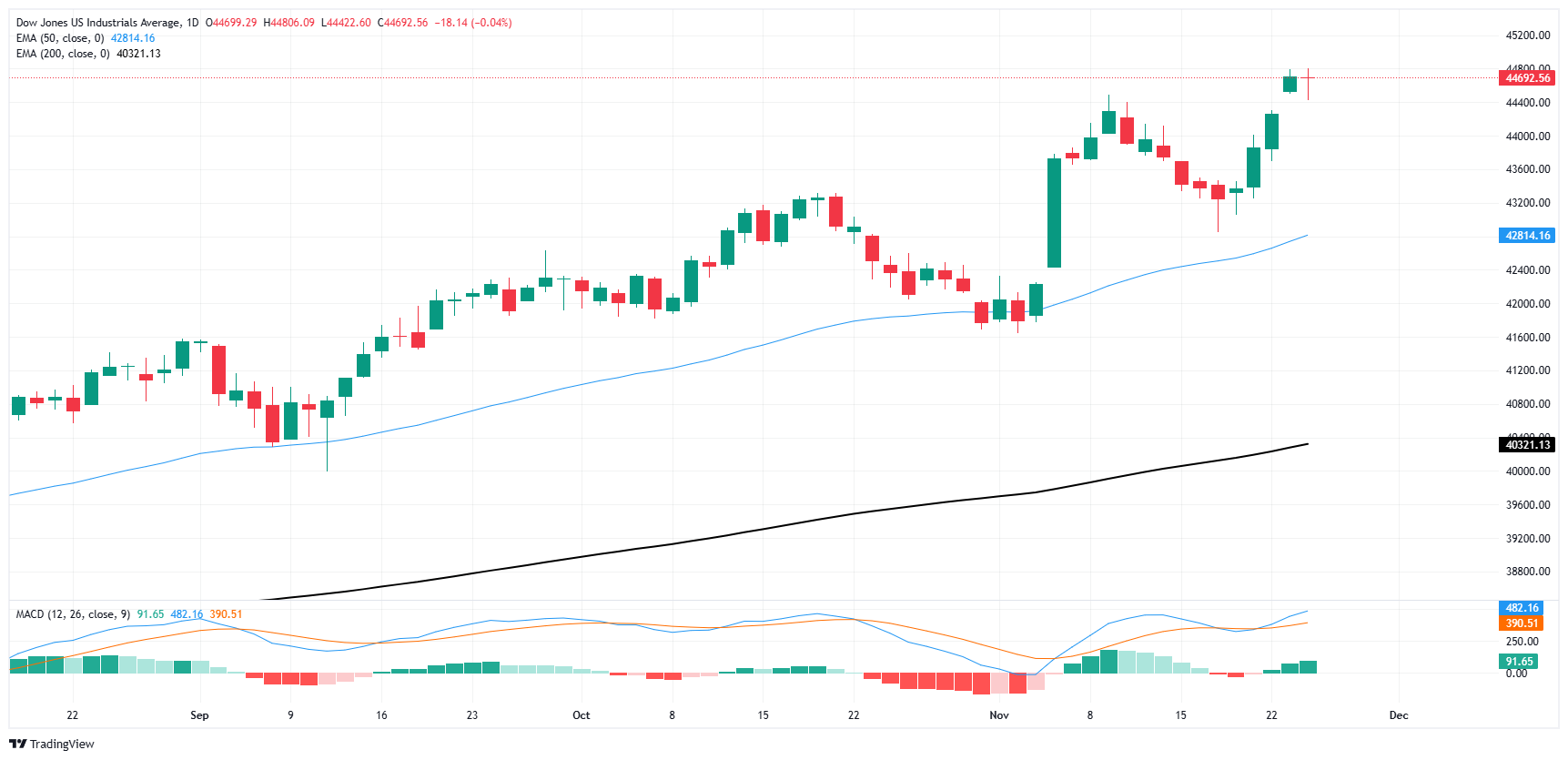- The Dow Jones stumbled on Tuesday, weighed down by key losses at Amgen.
- Stocks have largely ignored renewed tariff threats from incoming President Donald Trump.
- Key inflation data coming later in the week.
The Dow Jones Industrial Average (DJIA) retreated on Tuesday, losing more than 250 points at its lowest point. Investors dismissed renewed threats of widespread tariffs on foreign goods from incoming President Donald Trump, but slightly below expectations results for an experimental diet pill from Amgen (AMGN) dragged the DJIA-weighted lower for the day. The main stock index has since recovered to be flat on the day, with losses concentrated in key overweight stocks.
President-elect Donald Trump reiterated his threats to impose widespread tariffs on all goods imported into the U.S. early Tuesday. With his return to the White House scheduled for January, former President Trump issued a warning on social media that he intends to impose a 25% tariff on all goods coming from Canada and Mexico, with an additional 10% levy. % targeted specifically at Chinese goods. Investors largely dismissed the threat, believing that President Trump will eventually back off his plan to impose an import tax on the entire US economy. To the credit of investors, President Trump has backed off somewhat from his extreme stance on arbitrary tariffs; The Republican candidate’s initial tariff proposals presented in the campaign included import tariffs of up to 65% on all Chinese goods crossing the US border.
Investors are awaiting the latest Federal Reserve (Fed) meeting minutes, which will be released later during Tuesday’s US market window. No particularly shocking revelations are expected, especially as speculation about rate cuts has taken a back seat in traders’ minds in recent weeks. However, markets will still closely scrutinize the Fed’s latest deliberations to try to figure out how big the rate cut investors expect in December should be.
Wednesday will follow with another update to the US Personal Consumption Expenditure Price Index (PCEPI), a key reading of the price increases underpinning the US economy. Wednesday also brings a quarterly update on US Gross Domestic Product (GDP) growth. PCEPI annualized core inflation is expected to accelerate again in October and is forecast to rise to 2.8% from 2.7% previously. US QoQ GDP growth in the third quarter is expected to remain stable at 2.8%.
Dow Jones News
Even as stocks generally held a balanced stance on Tuesday, the Dow suffered a disproportionate drop after Amgen reported the latest results for its experimental weight-loss drug that fell short of investor expectations. Two-thirds of the Dow Jones is leaning on the day’s high side, but Amgen plunged as much as 12% at its lowest point after investors became disappointed with the drugmaker’s latest tests. Amgen has regained some ground and is currently down around 8%, trading around $270 per share.
Dow Jones Price Forecast
The Dow Jones navigates turbulent waters near 44,700 on Tuesday, finding an intraday bottom near 44,400 before stabilizing at the day’s opening bids. The major stock index briefly set another all-time record bid just above 44,800, but the bulls are beginning to show signs of exhaustion.
The immediate floor for any bearish retracement is valued at the latest swing low, with candlesticks populating territory near 43,200. However, any bearish momentum will quickly encounter more technical support from the 50-day EMA rising through 42,800.
Dow Jones Daily Chart
The Dow Jones FAQs
The Dow Jones Industrial Average, one of the world’s oldest stock indices, is made up of the 30 most traded securities in the United States. The index is weighted by price rather than capitalization. It is calculated by adding the prices of the securities that comprise it and dividing them by a factor, currently 0.152. The index was founded by Charles Dow, also founder of the Wall Street Journal. In recent years it has been criticized for not being sufficiently representative, since it only follows 30 companies, unlike broader indices such as the S& P 500.
There are many factors that drive the Dow Jones Industrial Average (DJIA). The main one is the aggregate performance of its component companies, revealed in quarterly corporate earnings reports. US and global macroeconomic data also contribute, influencing investor sentiment. The level of interest rates, set by the Federal Reserve (Fed), also influences the DJIA, as it affects the cost of credit, on which many companies largely depend. Therefore, inflation can be a determining factor, as well as other parameters that influence the Federal Reserve’s decisions.
The Dow Theory is a method for identifying the main trend of the stock market developed by Charles Dow. A key step is to compare the direction of the Dow Jones Industrial Average (DJIA) and the Dow Jones Transportation Average (DJTA) and only follow trends where they are both moving in the same direction. Volume is a confirmation criterion. The theory uses elements of maximum and minimum analysis. The Dow theory proposes three phases of the trend: accumulation, when the smart money begins to buy or sell; public participation, when the general public joins the trend; and distribution, when the smart money abandons the trend.
There are several ways to trade the DJIA. One of them is to use ETFs that allow investors to trade the DJIA as a single security, instead of having to buy shares of the 30 companies that comprise it. A prominent example is the SPDR Dow Jones Industrial Average ETF (DIA). Futures contracts on the DJIA allow traders to speculate on the future value of the index, and options provide the right, but not the obligation, to buy or sell the index at a predetermined price in the future. Mutual funds allow investors to purchase a portion of a diversified portfolio of DJIA securities, providing exposure to the global index.
Source: Fx Street
I am Joshua Winder, a senior-level journalist and editor at World Stock Market. I specialize in covering news related to the stock market and economic trends. With more than 8 years of experience in this field, I have become an expert in financial reporting.







